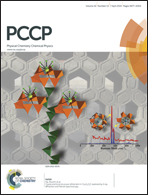RNA triplex-to-duplex and duplex-to-triplex conversion induced by coralyne
Abstract
Spectrophotometric, circular dichroism, calorimetric, displacement assay and kinetic analyses of the binding of the fluorescent dye coralyne to poly(A)2poly(U) have served to enlighten the ability of the dye to produce dramatic changes in the RNA structure. The sets of data assembled convey that coralyne is able to induce the triplex-to-duplex conversion and also the duplex-to-triplex conversion according to a non-reversible cycle governed by temperature, provided that the [dye]/[polymer] ratio (CD/CP) is maintained constant above unity. Alternatively, at room temperature the triplex is formed at (roughly) CD/CP < 1 and the duplex at CD/CP > 1.


 Please wait while we load your content...
Please wait while we load your content...